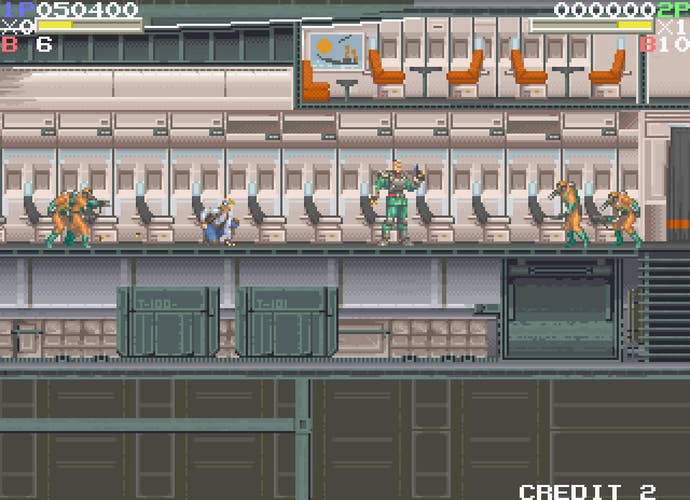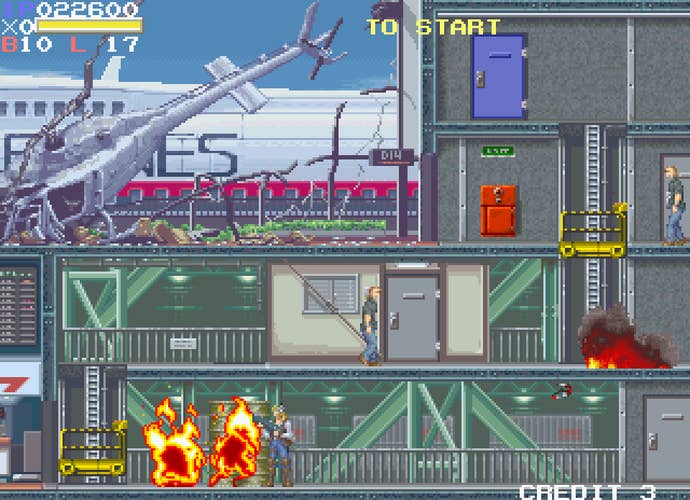Daily Classic: Elevator Action II, An Arcade Oddity Too Beautiful for This Miserable World
What if they held a sequel and no one came?
This article first appeared on USgamer, a partner publication of VG247. Some content, such as this article, has been migrated to VG247 for posterity after USgamer's closure - but it has not been edited or further vetted by the VG247 team.
I first discovered Taito's Elevator Action II in about 2002, a good eight years after its debut. By that point, it was a bizarre curiosity: An old-school 2D platform shooting game in an era where arcades had become spaces for congregations of teens to try and out-dance one another.
But I suspect Elevator Action II would have felt an oddity even in its own time. Even Taito's decision to resurrect the Elevator Action brand after more than a decade of silence alone made this one odd; what prompted them to look back in the archives and say, "Ah, yes, here's a minor hit from the early '80s. Let's totally bring this back as a more contemporary game." It wasn't quite as out of place as Strider 2, but it was close. The scrolling action format that Elevator Action II adopted had already become a vanishing breed in the arcades by 1994; before too long, it would be moribund on consoles as well.

Change was afoot for video games in the mid-'90s, and Elevator Action II felt in many ways like the last dinosaur grazing blithely before the meteor impact: A lonely holdout from the '80s. Besides bearing the name of a game that had last been relevant circa 1983, it played more or less like Namco's Rolling Thunder, itself a game from 1985. Despite a few high-profile successes such as Contra and Strider, the 2D platformer had never really found much traction in arcades. So why on earth did Taito adopt that format for its Elevator Action revival?
Honestly, we'll probably never know. Maybe it's OK, though; as it turns out, Elevator Action II may have been dated, but it was a lot of fun. I suspect the fact that it didn't have a lot of contemporaries had a liberating effect, of sorts. There was no leader to follow, no keeping up with the latest trends. Taito was well outside the bounds of the mainstream, and they kind of went hog-wild with the game.
First things first, though; Elevator Action II didn't feature nearly the same emphasis on vertical movement as its predecessor. Make no mistake, it included plenty of elevators and escalators, but they didn't dominate the design of every level. Some stages, most notably the running battle through the airport, featured a much more horizontal design than one might expect from a game that supposedly centered around riding boxes up and down. On the other hand, when levels did factor in elevators, they totally went for it, presenting players with cascades of elevators cars almost mazelike in their byzantine (and not at all architecturally sound) arrangements.

The original Elevator Action had a fairly simplistic premise: Players controlled a secret agent descending a tall skyscraper, riding elevators downward and grabbing secret documents from specially marked doors along the way. The sequel retained the essence – you couldn't complete a stage without visiting all the red doors – but amped up the intensity. Up to two people could play cooperatively, taking further cues from Rolling Thunder to duck into rooms along the way either for shelter or to acquire ammunition or health pickups. And of course there were plenty of curiously responsive elevators along the way, quick to respond to upward and downward movements.
In a lot of ways, Elevator Action II was an early example of cover-based shooting. You really needed to make use of the movement of elevators and the protective shelter of doors to evade enemy fire. Speaking of fire, that was another way in which the game felt curiously ahead of its time; each of the three selectable characters (a feature carried over from the ambitious Game Boy adaptation of the original Elevator Action) commanded use of a limited-use special weapon that could practically fill the screen with explosions and flames. Enemies caught in these blasts would catch fire themselves, thrashing briefly before expiring messily (a fact that came in handy during certain enemy waves in which, for example, a steady stream of jetpack troopers would zoom in to attack; lay down a constant field of firebombs and they'd die in droves the instant they landed). It was just cartoonish enough not to seem gruesome; far more unsettling these days is the fact that Elevator Action II let you kill enemy dobermans — something modern games are far too squeamish to allow.

Like the best arcade games, Elevator Action II paired its overall brevity (you can reach the end in 30 minutes, easily) with constant changes and surprises. Sure, maybe it never quite reached the level of Strider. On the other hand, how many other games saw you reach the top of a high-rise building only to have the villain blow the roof and mock you from a helicopter? Admittedly, the set pieces didn't always work; the final stage saw players racing against a ridiculously short deadline to stop the launch of a nuclear missile with no chance for a do-over. Blow it, and that was it; your entire play session had been for naught.
Perhaps Elevator Action II was a game out of time. But it was well-made, if conceptually somewhat baffling, and like so many projects clearly borne of misguided enthusiasm it managed to be a lot of fun. Brief, energetic, and even better with a friend, Elevator Action II never would have happened in a saner world. So thank goodness for the mad reality we live in.








